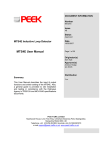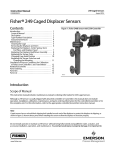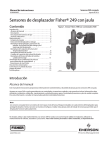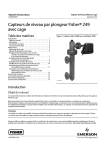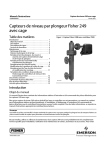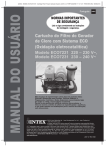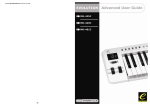Download Evolution Technologies 249 Electronic Keyboard User Manual
Transcript
Evolution USB Keyboards 249/361 USB MIDI Controller Keyboard 225C/249C/361C USB MIDI Controller Keyboard with additional programmable rotary controllers WWW.EVOLUTION.CO.UK EVOLUTION 249/361/225C/249C/361C MIDI KEYBOARD MANUAL 1. POWER SUPPLY There are three methods of powering the Evolution USB Keyboard. Only use one method at one time Soundcard as power source Using the supplied self powered connector cable connect the 5 pin male plug to the Evolution MIDI keyboard and the 15 pin male plug to the MIDI port on your PC soundcard. IMPORTANT – DO NOT USE THIS CABLE TO POWER ANY OTHER EQUIPMENT or AC Power You can also use an AC adapter (not included) with the following specification: 9-12V DC output, 250-300mA, centre positive. or USB Connect to the USB port on your computer. The keyboard is powered from USB. Note: Do not leave the adapter plugged in for long periods of time if the unit is not in use. 2. Preparation 2-1 Connect the unit with other MIDI equipment you may have: You can connect the keyboard to any other MIDI device such as a sound module or drum machine as shown below. Note that the keyboard does not have MIDI in capability and so can not receive MIDI data. If you are not connecting via USB, you will need to use an external power supply to connect to other MIDI devices. If you are using USB the keyboard will be powered from the USB port and the external power supply is not necessary. The keyboard can act in MIDI THRU mode receiving data from the computer and transmitting it to any other connected MIDI device. Turn on the POWER switch. Turn all other equipment on. Press the BANK MSB and TRANSPOSE simultaneously to select ‘MIDI out from USB’ (only necessary if using the USB port). 3. Demo Pressing octave up and down together plays a short demonstration. Please note that the sounds are set for a GM sound system and the demo will sound differently on other sound synthesizers. Press the octave up and down keys once more to end demo. 4. Entering Numbers When any number is entered it adheres to the following rules:Increment/Decrement Keys Initially the LED display starts flashing. The value displayed can be incremented/decremented using the +/- keys. Pressing both + & - should call up the default value for that parameter. The LED display shows the new value. The new value is sent out except for the CONTROL ASSIGN which sends data when the display stops flashing) When the display stops flashing the keyboard returns to normal operation. Numeric Keys Initially the LED display starts flashing. A numeric value can be typed in using the numbers 0-9. As each key is pressed the display continues to flash, the time-out value is reset. When a complete number* has been entered the display stops flashing and the value is selected. Alternatively, if no key is pressed and the display stops flashing the number on the display is selected. The update routine is triggered, so that the new value is sent out. When the display stops flashing the keyboard returns to normal operation. * The following table shows how many keys are required to enter a complete number:- Channel Memory Program Changes Bank LSB/MSB Control Select Control Assign 5. 1 key 2-9 0-9 2-9 2 keys 01,10-16 3 keys 13-99 13-99 01,10-14 14-99 000-012, 100-127 000-012, 100-127 000-013, 100-132 Sending a PROGRAM CHANGE number Using the PROGRAM switch and the numeric keys, you can send any MIDI PROGRAM CHANGE from 0-127. Press the PROGRAM switch. The LED starts to flash showing the current PROGRAM number (instrument sound). Press the numeric keys to alter the PROGRAM CHANGE number. You can also use the “+” or “-” keys to change the value. Note: * if you don’t do anything for 3 seconds the LED stops flashing and shows the current PROGRAM CHANGE number. À if the number you press is larger than 127, it will return to the previous PROGRAM CHANGE number. 6. PROGRAM & BANK CHANGE MEMORY You can assign a selected PROGRAM CHANGE as well as a BANK LSB and a BANK MSB to one of ten numeric keys (0-9). Once stored, simply pressing one of the numeric keys will send the desired PROGRAM and BANK CHANGES. The stored information is held in non-volatile memory which will remember even if the power is turned off. Select the desired PROGRAM CHANGE, BANK LSB and MSB. Please refer to respective chapters for information on how to do this. Press the MEMORY switch. The LED starts to flash. Press the numeric key (from 0 to 9) you wish to assign the data to. The PROGRAM and BANK CHANGE information is stored on the selected numeric key. 7. Setting the MIDI Transmit Channel There are 16 MIDI transmit channels available. Once you have set the unit’s MIDI channel, the unit sends all MIDI messages on this MIDI channel. Be sure to match the channel with the RECEIVE channel of any connected equipment. Press the CHANNEL switch. The LED shows the present TRANSMIT channel Press one (or two) of the numeric keys to change the channel. The LED changes to the pressed number. You can also use +/- switches to increase or decrease the value. Note: * if you do nothing after step 3-1 for 3 seconds, the LED will return to show the present PROGRAM CHANGE number. The default CHANNEL is 1 when power is turned on. If you have a MK-225C/MK-249C/MK-361C, you can assign each of the rotary controls to a different channel individually. You can store a single channel for each of the controllers that is independent of the Keyboard channel. This allows you to transmit control data on multiple channels simultaneously. To do this: 1. Press both 'CONTROL SELECT' buttons and release. 2. The LED display shows the current controller which has been selected. 3. As the LED toggles the display between the new controller and its assignment, presss the CHANNEL button. A small ‘c’ in the first digit indicates that it is displaying the channel for the selected controller, the other 2 digits display the current controller channel. 4. Press one (or two) of the numeric keys to change the channel. The LED changes to the pressed number. 5. You can also use +/- switches to increase or decrease the value. Note: You can select a new controller by moving any one of the rotary controllers. If you have one of the new blue LED keyboards you can alternatively use the 'CONTROL ASSIGN' buttons. When a Controller is assigned a channel of 0 it means that rather than have a single, assigned channel it reads the current Keyboard channel instead and generates MIDI data on the same channel as notes played on the keyboard. 8. SLIDER ASSIGN Moving the SLIDER transmits MIDI CONTROL CHANGE messages to any connected equipment. The Slider defaults to sending Channel Volume messages on the selected channel, but you can re-assign the slider to any other controller. Number 1 – 127 128 129 130 131 132 Functions Standard MIDI controllers Pitch Bend Sensitivity Fine Tune Coarse Tune Channel Pressure Velocity With Evolution 249/361. Press the SLIDER ASSIGN switches (PROGRAM & BANK LSB) together and the LED starts to flash showing the number of the present MIDI controller. Use numeric keys 0-9 to select a new MIDI controller. You can also use the +/- switches to increase or decrease the value of the number. With Evolution 225C/249C/361C. Press the CONTROL SELECT switches (MEMORY & PROGRAM) and the LED starts to flash showing the number of the present MIDI controller. Move the slider. Alternatively, press numeric keys 0-9 to select a new MIDI controller. You can also use the +/switches to increase or decrease the value of the number. The LED display should flash C13. Note: * If you do nothing for 3 seconds, the LED will return to show the current PROGRAM CHANGE number. * If the number you press is not in the range of defined numbers, the previous number will be retained. * When you assign 120 or 121 as the MIDI controller for the WHEEL, you should move the MODULATION Wheel to the mid-value then return it to the minimum value to send a relative MIDI message. See Appendix B for a full list of controller numbers. 9. PITCH BEND WHEEL Moving the PITCH BEND WHEEL transmits MIDI PITCH BEND messages to any connected equipment. This allows you to bend the pitch of a sound up (or down one tone) to add expression to your performance. To bend the sound up: Move the WHEEL away from you. To bend the sound down: Move the WHEEL towards you. 10. WHEEL ASSIGN Use the WHEEL to transmit MIDI CONTROL CHANGE messages. You can select and assign 119 types of MIDI functions (1-31, 33-95, 102-121, 128-132) Number 1 –127 128 129 130 131 132 Functions Standard MIDI controllers Pitch Bend Sensitivity Fine Tune Coarse Tune Channel Pressure Velocity With Evolution 249/361. Press the WHEEL ASSIGN switches (MEMORY & PROGRAM) together and the LED starts to flash showing the number of the present MIDI controller. Use numeric keys 0-9 to select a new MIDI controller. You can also use the +/- switches to increase or decrease the value of the number. With Evolution 225C/249C/361C. Press the CONTROL SELECT switches (MEMORY & PROGRAM) and the LED starts to flash showing the number of the present MIDI controller. Either move the wheel, or press numeric keys 0-9 to select a new MIDI controller. You can also use the +/- switches to increase or decrease the value of the number. The LED display should flash C14. Note: * If you do nothing for 3 seconds, the LED will return to show the current PROGRAM CHANGE number. * If the number you press is not in the range of defined numbers, the previous number will be retained. * When you assign 120 or 121 as the MIDI controller for the WHEEL, you should move the MODULATION Wheel to the mid-value then return it to the minimum value to send a relative MIDI message. * See Appendix B for a full list of controller numbers. 11. TRANSPOSE This function allows you to shift the pitch of the unit in semitones. You can transpose the pitch by 24 half steps (12 up, 12 down). Press the TRANSPOSE switch. The LED shows the current TRANSPOSE value. Press the “+” or “-” switch to change the TRANSPOSE value. Each time you press + or -, the keyboard is transposed an additional half step. * Pressing the + and - switches simultaneously resets the pitch to the default value. Note: Turning the power off always resets the shifted pitch to the default value. 12. OCTAVE CHANGE This function allows you to shift the pitch up to three octaves higher or two lower. Press the OCTAVE UP or DOWN to change the octave range. The LED shows the new OCTAVE value. * Press OCTAVE UP and DOWN switches simultaneously to reset the pitch to the default value. Note: if the UP or DOWN switch is not pressed for 3 seconds, the LED will return to show the PROGRAM CHANGE number. 13. Sending BANK MSB and LSB message You can send any value of MSB or LSB from 0-127. Press the BANK LSB switch. The LED starts to flash showing the current value of the LSB. Press the numeric keys to change the LSB value. You can also use the “+” or “-” switches to change the value. Press the BANK MSB switch. The LED starts to flash showing the current value of the MSB. Press numeric keys to change the MSB value. You can also use the “+” or “-” switches to change the value. Note: * if you don’t do anything for 3 seconds the LED stops flashing and shows the current PROGRAM CHANGE number. * if the number you input is over 127, it will return to the previous LSB or MSB value. 14. Selecting a VELOCITY CURVE The VELOCITY CURVEs determine the relationship between how hard the keys are struck and the corresponding velocity that the unit transmits. This unit allows you to select from 12 VELOCITY CURVEs. Simultaneously press the CHANNEL and MEMORY switches. The LED starts to flash showing the current number of the VELOCITY CURVE. Press one of the numeric keys to select a VELOCITY CURVE. The 10 key numbers correspond to the first 10 VELOCITY CURVEs as follows: You can also use the “+” or “-” switches to access all the VELOCITY CURVEs. There are 3 Fixed VELOCITY CURVEs which output the following velocity values: Curve Velocity 64 F0 100 F1 127 F2 These are achieved by selecting velocity curve 09. F0 will appear on the LED. Use the “+” or “-“ keys to select F0F2. Note: If you don’t do anything for 3 seconds the LED stops flashing and shows the current PROGRAM CHANGE number. 15. MIDI OUT FROM USB The MIDI output connector is normally used to send MIDI data from the keyboard. If the keyboard is connected to a computer using USB the MIDI Out can also be used to send data received from USB. Pressing both ‘MIDI OUT FROM USB’ buttons flashes the current setting on the LCD display. The +/- keys can be used to alter the current setting. + selects YES, - selects NO. Pressing both + and – calls up the default setting which is NO. When ‘NO’ is selected the MIDI Out sends the data from the keyboard. When YES is selected the MIDI Out sends the MIDI data received from USB. The status of MIDI OUT FROM USB will be saved in non-volatile memory and restored when the keyboard is switched on again. The factory default is set to NO 16. GM RESET (GENERAL MIDI RESET) – Evolution 249/361 Only This function allows you to send a GENERAL MIDI MODE RESET message. Press the BANK LSB and BANK MSB keys together. Hold the keys down for at about 2 seconds and the reset message is sent. Evolution 225C/249C/361C Only 17. Assignable Rotary controllers All these assignable controllers are selected by the ‘CONTROL SELECT’ & 'CONTROL ASSIGN' functions for these keyboards. ‘Assignable Controllers’ refers to any of the 8, 12 or 16 assignable Knobs and also includes the assignable Wheel and Slider. The Slider is Assignable Controller 13 or 17(for MK249C and MK-361C only), the Wheel is Assignable Controller 9, 14 or 18. The basic operation is:Press the CONTROL SELECT buttons together. Select the controller by moving it or by typing the number in. Press the CONTROL ASSIGN buttons and enter the new number using the keypad. To change one of the assignable controllers, the keyboard uses the following method: Press both 'CONTROL SELECT' buttons and release. The LED display shows the current Controller which has been selected. The LED’s toggle between the controller number and the assigned value. E.g. initially it would toggle between c14 & 01, showing that the Wheel is assigned to the Modulation Wheel controller. Select a controller by moving any one of the assignable controllers, the numeric keypad or the +/- keys. The LED then toggles the display between the new controller and its assignment. Repeat this process to see the controller number assignment (0-132) for any Knob, Slider or the Wheel, by moving the relevant controller or by typing a new number. If no keys are pressed or any of the assignable controllers moved, the LED display stops flashing after 3 seconds and returns to normal operation. Press both 'CONTROL ASSIGN' buttons and release. The number entered at this point will be assigned to the last selected controller. The numeric entry uses the standard data entry system. (see section on Entering Numbers) If a complete number is entered the display stops flashing and the new assignment is stored. If the +/- keys are used, the revised value is shown on the LED display and the flashing time-out is reset. Once a controller has been assigned the current knob/slider/wheel position should be sent out. This ensures that when the controller if first moved it does not trigger a large jump from it’s previous setting. During the data entry stage while the LED display is flashing, the Knobs, Slider and the Wheel do not function. The MIDI keyboard should continue to function at all times 18. Snap Shot When both SNAP SHOT keys are pressed the MK-249C sends out the settings for all of the Assignable Controllers on the current selected channel. This feature lets you record the settings of the Knobs, Slider & Mod Wheel into your sequencer. 19. SPECIFICATIONS Evolution 249: 1. Keyboard: 49 standard keys (Velocity sensitive) 2. Control: Switches: (WHEEL, CHANNEL, PROGRAM, MEMORY, TRANSPOSE, GM RESET, VEL CURVE, BANK LSB, BANK MSB, OCTAVE DOWN, OCTAVE UP, POWER ON/OFF, Numeric Keys (0-9), , +) 3. Control: Sliders: (PITCH BEND WHEEL, MODULATION WHEEL, CHANNEL VOLUME/DATA ENTRY) 4. Memory storage – non volatile 5. Display: 3 digit LED 6. Jack: DC IN (DC 9V), MIDI OUT, SUSTAIN, USB 7. Dimension: 800 x210 x80 (mm). Weight: 4 kg Note: Specifications are subject to change without prior notice. Evolution 361: 1. Keyboard: 61 standard keys (Velocity sensitive) 2. Control: Switches: (WHEEL, CHANNEL, PROGRAM, MEMORY, TRANSPOSE, GM RESET, VEL CURVE, BANK LSB, BANK MSB, OCTAVE DOWN, OCTAVE UP, POWER ON/OFF, Numeric Keys (0-9), , +) 3. Control: Sliders: (PITCH BEND WHEEL, MODULATION WHEEL, CHANNEL VOLUME/DATA ENTRY) 4. Memory storage – non volatile 5. Display: 3 digit LED 6. Jack: DC IN (DC 9V), MIDI OUT, SUSTAIN, USB 7. Dimension: 970 x220 x80 (mm). Weight: 5 kg Note: Specifications are subject to change without prior notice Evolution 225C: 1. Keyboard: 49 standard keys (Velocity sensitive) 2. Control: Switches: (WHEEL, CHANNEL, PROGRAM, MEMORY, TRANSPOSE, GM RESET, VEL CURVE, BANK L, BANK M, RESET-AC, OCTAVE DOWN, OCTAVE UP, POWER ON/OFF, Numeric Keys (0-9), ?, +) 3. Control: Sliders: (PITCH BEND WHEEL, MODULATION WHEEL, CHANNEL VOLUME/DATA ENTRY) 4. Rotary Controls: 12 rotary controls with assignable controller values 5. Memory storage – non volatile 6. Display: 3 digit LED 7. Jack: DC IN (DC 9V), MIDI OUT, SUSTAIN, USB 8. Dimension: 480 x220 x80 (mm) 9. Weight: 2.3 kg Note: Specifications are subject to change without prior notice. Evolution 249C: 1. Keyboard: 49 standard keys (Velocity sensitive) 2. Control: Switches: (WHEEL, CHANNEL, PROGRAM, MEMORY, TRANSPOSE, GM RESET, VEL CURVE, BANK L, BANK M, RESET-AC, OCTAVE DOWN, OCTAVE UP, POWER ON/OFF, Numeric Keys (0-9), ?, +) 3. Control: Sliders: (PITCH BEND WHEEL, MODULATION WHEEL, CHANNEL VOLUME/DATA ENTRY) 4. Rotary Controls: 12 rotary controls with assignable controller values 5. Memory storage – non volatile 6. Display: 3 digit LED 7. Jack: DC IN (DC 9V), MIDI OUT, SUSTAIN, USB 8. Dimension: 800 x210 x100 (mm) 9. Weight: 4 kg Note: Specifications are subject to change without prior notice. Evolution 361C: 1. Keyboard: 61 standard keys (Velocity sensitive) 2. Control: Switches: (WHEEL, CHANNEL, PROGRAM, MEMORY, TRANSPOSE, GM RESET, VEL CURVE, BANK L, BANK M, RESET-AC, OCTAVE DOWN, OCTAVE UP, POWER ON/OFF, Numeric Keys (0-9), ?, +) 3. Control: Sliders: (PITCH BEND WHEEL, MODULATION WHEEL, CHANNEL VOLUME/DATA ENTRY) 4. Rotary Controls: 16 rotary controls with assignable controller values 5. Memory storage - non volatile 6. Display: 3 digit LED 7. Jack: DC IN (DC 9V), MIDI OUT, SUSTAIN, USB 8. Dimension: 970 x220 x100 (mm) 9. Weight: 5 kg Note: Specifications are subject to change without prior notice. APPENDIX A MIDI IMPLEMENTATION CHART Function Basic :Default Channel:Changed :Default Mode :Messages :Altered Note Number:True Voice Velocity: Note ON : Note OFF After :Key’s Touch :Ch’s Pitch Bend 0,32 1 Control 6 Change 7 64 1-31 33-95 102-121 Program Change:True Number System Exclusive :Song Position Common:Song Select :Tune System :Clock Exclusive:Commands Aux :Local ON/OFF Messages:All Notes OFF :Active Sense :Reset Notes: Transmitted 1-16 1-16 --------X ********* 0-127 ********* 0 X X • 0 • • • 0 0 Received Bank select Modulation Data Entry Volume Hold 1 Mod Wheel Assign • • • 0-127 ********* X X X X X X X X 0 X • : Can be Remarks set to 0 or X For support email [email protected] Latest drivers and information at www.evolution.co.uk Join the Evolution User’s group at Yahoo groups, www.yahoogroups.com/group/evolution-users or e-mail to this address: [email protected] APPENDIX B STANDARD CONTROLLER NUMBERS No. Controller No. Controller No. Controller 00 01 02 03 04 05 06 07 08 09 10 11 12 13 14 15 16 17 18 19 20 21 22 23 24 25 26 27 28 29 30 31 32 33 34 35 36 37 38 39 40 41 42 43 44 45 46 47 48 49 50 Bank Select Modulation Breath Control Controller 3 Foot Control Porta Time Data Entry Channel Volume Balance Controller 9 Pan Expression Effects Controller 1 Effects Controller 2 Controller 14 Controller 15 Gen Purpose 1 Gen Purpose 2 Gen Purpose 3 Gen Purpose 4 Controller 20 Controller 21 Controller 22 Controller 23 Controller 24 Controller 25 Controller 26 Controller 27 Controller 28 Controller 29 Controller 30 Controller 31 Bank Select LSB Modulation LSB Breath Control LSB Controller 35 Foot Control LSB Porta Time LSB Data Entry LSB Channel Volume LSB Balance LSB Controller 41 Pan LSB Expression LSB Controller 44 Controller 45 Controller 46 Controller 47 Gen Purpose 1 LSB Gen Purpose 2 LSB Gen Purpose 3 LSB 51 52 53 54 55 56 57 58 59 60 61 62 63 64 65 66 67 68 69 70 71 72 73 74 75 76 77 78 79 80 81 82 83 84 85 86 87 88 89 90 91 92 93 94 95 96 97 98 99 100 101 Gen Purpose 4 LSB Controller 52 Controller 53 Controller 54 Controller 55 Controller 56 Controller 57 Controller 58 Controller 59 Controller 60 Controller 61 Controller 62 Controller 63 Sustain Pedal Portamento Sostenuto Soft Pedal Legato Pedal Hold 2 Sound Variation Resonance Release Time Attack Time Cutoff Frequency Controller 75 Controller 76 Controller 77 Controller 78 Controller 79 Gen Purpose 5 Gen Purpose 6 Gen Purpose 7 Gen Purpose 8 Portamento Control Controller 85 Controller 86 Controller 87 Controller 88 Controller 89 Controller 90 Reverb Depth Tremelo Depth Chorus Depth Celeste (De-tune) Phaser Depth Data Increment Data Decrement Non-Reg Param LSB Non-Reg Param MSB Reg Param LSB Reg Param MSB 102 103 104 105 106 107 108 109 110 111 112 113 114 115 116 117 118 119 Controller 102 Controller 103 Controller 104 Controller 105 Controller 106 Controller 107 Controller 108 Controller 109 Controller 110 Controller 111 Controller 112 Controller 113 Controller 114 Controller 115 Controller 116 Controller 117 Controller 118 Controller 119 Channel Mode Messages 120 121 122 123 124 125 126 127 All Sound off Reset all Controllers Local Control All Notes Off Omni Off Omni On Mono On (Poly Off) Poly On (Mono Off) Extra Keyboard Messages Possible 128 129 130 131 132 Pitchbend sensitivity. Fine Tune Coarse Tune Channel Pressure Velocity












